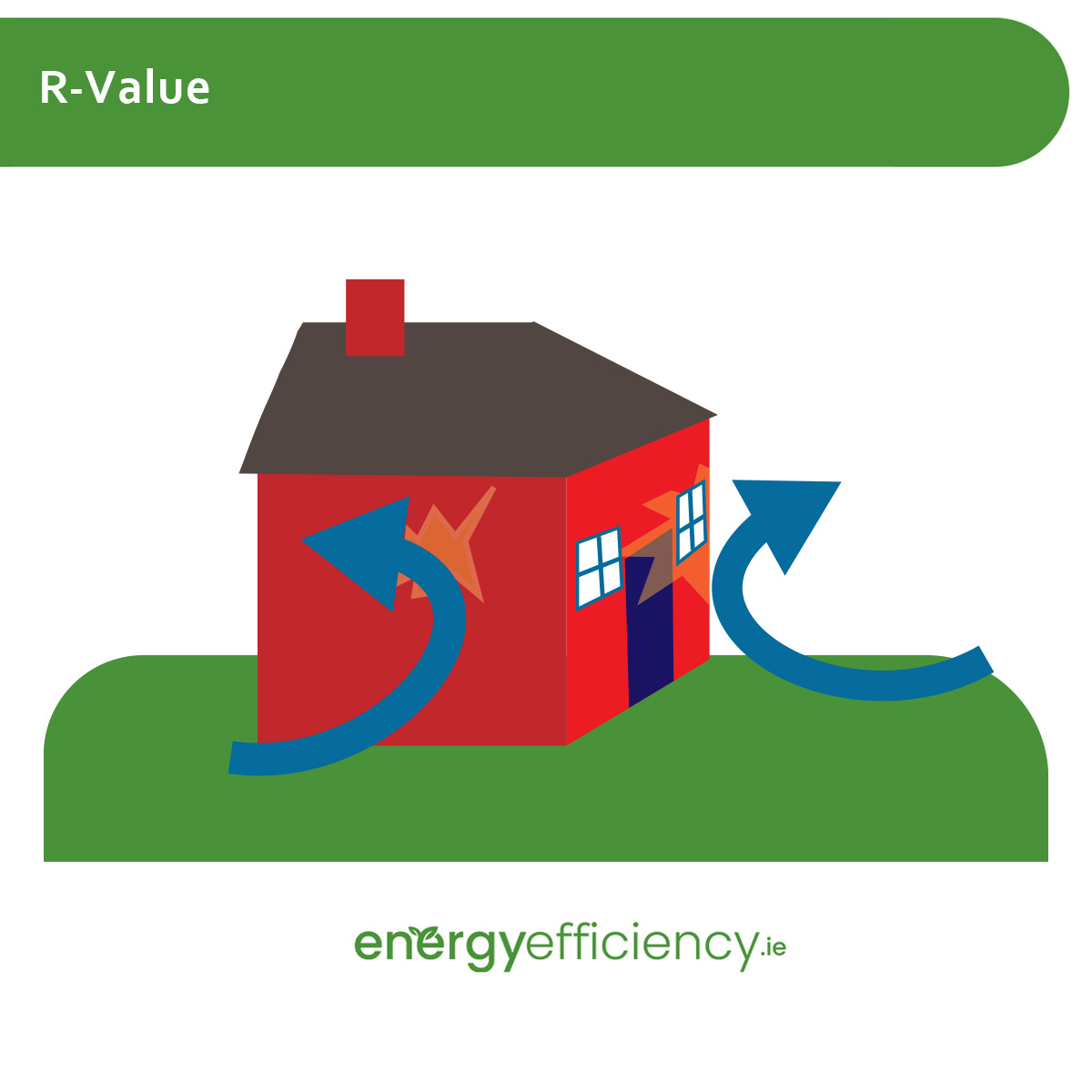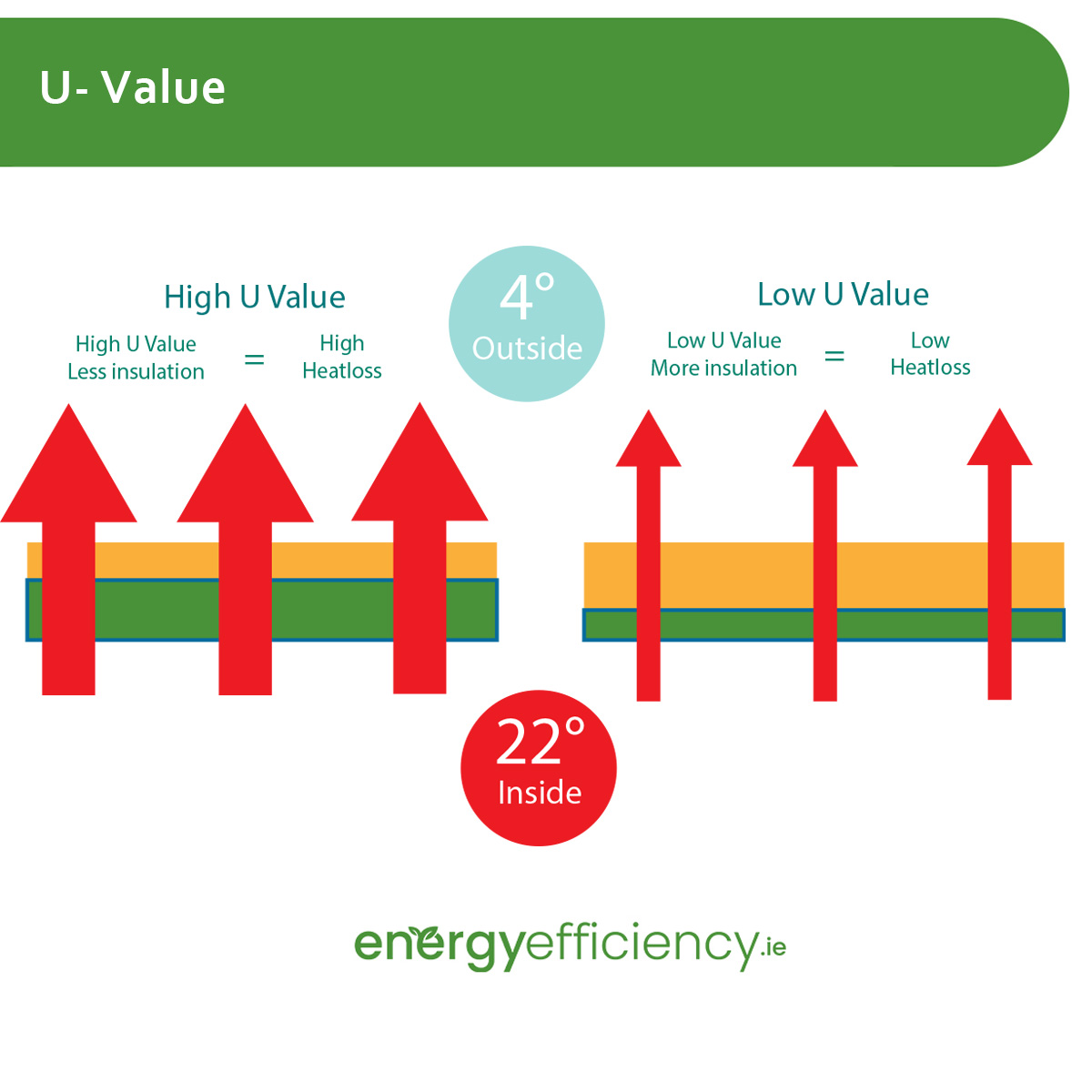Table of Contents
Understanding U-Values & R-Values

Written by: Briain Kelly
Published: June 6, 2024
Last updated: November 10, 2025
Reading time: 3 mins
There’s a lot of technical jargon that gets thrown around when talking about the performance of home energy upgrades such as insulation.
When getting home insulation installed or burying it online you’ll likely see and hear references to different values, in particular U-values and R-values.
Both of these are figures used to measure the thermal performance of insulation, but they differ in how it is measured and calculated.
A R-value is given for a single material and refers to how good it is at resisting the transfer of heat. The U-value in contrast is given for an area as a whole, such as a wall, and refers to the flow of heat through that structure.
Thermal Conductivity
Thermal Conductivity, represented by the Greek symbol Lambda 𝜆 is a measurement of how easily a material allows heat to pass through it.
This is expressed as Watts per Metre Kelvin W/mK and is independent of any other considerations such as the thickness of the insulation.

R-Values
An R-value refers to the thermal resistance of a material, a measurement of how good it is at blocking the transfer of heat through it. The higher the R-value of a material, the better it is at resisting the flow of heat.
The thickness of the material in question is essential for grasping the R-value. The thicker the layer of insulation, the higher an R-value it will have.
An R-value is calculated by dividing the thickness of the material by its thermal conductivity. It is expressed as metres squared Kelvin per Watt (m²K/W).
R = l/ – where 𝑙 is the thickness of the wall in metres and 𝜆 is the thermal conductivity of the material in W/mK.
If you are purchasing insulation for a DIY project, looking at the R-value of different products is an important metric for gauging their performance.
You can add together the R-values of insulation with those of the wall structure to produce a figure for its thermal resistance. However, R-values are limited in that they only take into account the conduction of heat, and not other ways in which heat can be lost from a building.

What is a U-Value
The U-value is an expression of the thermal transmittance of an element of a structure such as a wall or ceiling, outlining how much heat is lost through that structure.
A U-value is the reciprocal of an R-value and is expressed as the rate of heat transfer through a structure divided by the difference in temperature across that structure. It is expressed as Watts per metre squared Kelvin (W/m²K).
When a U-value is being calculated it takes conduction, convection and radiation into account, making workmanship extremely important when installing insulation.
Since U-values indicate how much heat is being lost through a structure, the lower the value the better when it comes to insulating your home.
Measuring U-Values
The U-value of a structure such as a cavity wall is calculated using all of the elements involved in the structure, such as blocks, plaster, and insulation, and looks at all the different ways in which heat can be lost through that wall.
Any air gaps or thermal bridges from poorly fitted insulation will result in greater heat loss and raise the U-value of a building.
The U-value of a structure can be measured manually using a thermopile sensor to measure the heat flow over a period of time. However, calculations can also be made using certified measured values for known materials.
Why It’s Important to Understand U-Values
The most obvious reason why it is important to understand U-values is because it is a determining factor in the comfort and thermal performance of your home.
If you are getting insulation installed on a home here in Ireland, the U-value is mostly what will be used to express the final thermal performance of the area in question once the upgrades are complete.
U-Values are also essential in home energy upgrades due to requirements in Building Regulations and SEAI grant funding.
When it comes to grant funding for home insulation upgrades, the SEAI sets certain U-Value thresholds which must be met in order to receive grants. Of course, there is nothing to say that you can’t exceed those targets and aim for an even lower U-value.
| U-Value Requirements for SEAI Better Energy Homes Grants | |
| Insulation Type | Required U-Value Target |
| Ceiling Insulation | 0.16 W/m²K |
| Rafter Insulation | 0.20 W/m²K |
| Cavity Wall Insulation | 0.35 W/m²K |
| External Wall Insulation | 0.27 W/m²K |
| Internal Wall Insulation | 0.27 W/m²K |
Irish Building Regulations also set standards for acceptable U-Values when carrying out upgrade works to existing buildings.
The relevant U-Values for the purpose of Part L Building Regulations is where the wall, roof, etc separates the interior of the building from the outside, directly or indirectly. Walls between two heated areas (e.g. between apartments or semi-detached houses) are not relevant.
These acceptable values can be relaxed for elements of a building, or even parts of an individual element. However, this should only be done when necessary for construction or design reasons.
The building regulations also expect you to compensate for this elsewhere in order to still hit that area-weighted average.
| Maximum elemental U-Value for Material Alterations or Material Change of Use | ||
| Building Element | Area-weighted Average Elemental U-Value | Average Elemental U-value – individual element or section of element |
| Pitched Roof – Rafters | 0.25 W/m²K | 0.35 W/m²K |
| Pitched Roof – Ceiling | 0.16 W/m²K | |
| Flat Roof | 0.25 W/m²K | |
| Cavity Walls | 0.55 W/m²K | 0.6 W/m²K |
| Other Walls | 0.35 W/m²K | |
| Ground Floors | 0.45 W/m²K | |
| Other Exposed Floors | 0.25 W/m²K | 0.6 W/m²K |
| External Doors, Windows, Rooflights & Curtain Walling | 1.40 W/m²K | 3.0 W/m²K |
Understanding U-Values & R-Values
Published: June 6, 2024
Last updated: November 10, 2025

Written by: Briain Kelly
Reading time: 3mins
There’s a lot of technical jargon that gets thrown around when talking about the performance of home energy upgrades such as insulation.
When getting home insulation installed or burying it online you’ll likely see and hear references to different values, in particular U-values and R-values.
Both of these are figures used to measure the thermal performance of insulation, but they differ in how it is measured and calculated.
A R-value is given for a single material and refers to how good it is at resisting the transfer of heat. The U-value in contrast is given for an area as a whole, such as a wall, and refers to the flow of heat through that structure.
Thermal Conductivity
Thermal Conductivity, represented by the Greek symbol Lambda 𝜆 is a measurement of how easily a material allows heat to pass through it.
This is expressed as Watts per Metre Kelvin W/mK and is independent of any other considerations such as the thickness of the insulation.

R-Values
An R-value refers to the thermal resistance of a material, a measurement of how good it is at blocking the transfer of heat through it. The higher the R-value of a material, the better it is at resisting the flow of heat.
The thickness of the material in question is essential for grasping the R-value. The thicker the layer of insulation, the higher an R-value it will have.
An R-value is calculated by dividing the thickness of the material by its thermal conductivity. It is expressed as metres squared Kelvin per Watt (m²K/W).
R = l/ – where 𝑙 is the thickness of the wall in metres and 𝜆 is the thermal conductivity of the material in W/mK.
If you are purchasing insulation for a DIY project, looking at the R-value of different products is an important metric for gauging their performance.
You can add together the R-values of insulation with those of the wall structure to produce a figure for its thermal resistance. However, R-values are limited in that they only take into account the conduction of heat, and not other ways in which heat can be lost from a building.

What is a U-Value
The U-value is an expression of the thermal transmittance of an element of a structure such as a wall or ceiling, outlining how much heat is lost through that structure.
A U-value is the reciprocal of an R-value and is expressed as the rate of heat transfer through a structure divided by the difference in temperature across that structure. It is expressed as Watts per metre squared Kelvin (W/m²K).
When a U-value is being calculated it takes conduction, convection and radiation into account, making workmanship extremely important when installing insulation.
Since U-values indicate how much heat is being lost through a structure, the lower the value the better when it comes to insulating your home.
Measuring U-Values
The U-value of a structure such as a cavity wall is calculated using all of the elements involved in the structure, such as blocks, plaster, and insulation, and looks at all the different ways in which heat can be lost through that wall.
Any air gaps or thermal bridges from poorly fitted insulation will result in greater heat loss and raise the U-value of a building.
The U-value of a structure can be measured manually using a thermopile sensor to measure the heat flow over a period of time. However, calculations can also be made using certified measured values for known materials.
Why It’s Important to Understand U-Values
The most obvious reason why it is important to understand U-values is because it is a determining factor in the comfort and thermal performance of your home.
If you are getting insulation installed on a home here in Ireland, the U-value is mostly what will be used to express the final thermal performance of the area in question once the upgrades are complete.
U-Values are also essential in home energy upgrades due to requirements in Building Regulations and SEAI grant funding.
When it comes to grant funding for home insulation upgrades, the SEAI sets certain U-Value thresholds which must be met in order to receive grants. Of course, there is nothing to say that you can’t exceed those targets and aim for an even lower U-value.
| U-Value Requirements for SEAI Better Energy Homes Grants | |
| Insulation Type | Required U-Value Target |
| Ceiling Insulation | 0.16 W/m²K |
| Rafter Insulation | 0.20 W/m²K |
| Cavity Wall Insulation | 0.35 W/m²K |
| External Wall Insulation | 0.27 W/m²K |
| Internal Wall Insulation | 0.27 W/m²K |
Irish Building Regulations also set standards for acceptable U-Values when carrying out upgrade works to existing buildings.
The relevant U-Values for the purpose of Part L Building Regulations is where the wall, roof, etc separates the interior of the building from the outside, directly or indirectly. Walls between two heated areas (e.g. between apartments or semi-detached houses) are not relevant.
These acceptable values can be relaxed for elements of a building, or even parts of an individual element. However, this should only be done when necessary for construction or design reasons.
The building regulations also expect you to compensate for this elsewhere in order to still hit that area-weighted average.
| Maximum elemental U-Value for Material Alterations or Material Change of Use | ||
| Building Element | Area-weighted Average Elemental U-Value | Average Elemental U-value – individual element or section of element |
| Pitched Roof – Rafters | 0.25 W/m²K | 0.35 W/m²K |
| Pitched Roof – Ceiling | 0.16 W/m²K | |
| Flat Roof | 0.25 W/m²K | |
| Cavity Walls | 0.55 W/m²K | 0.6 W/m²K |
| Other Walls | 0.35 W/m²K | |
| Ground Floors | 0.45 W/m²K | |
| Other Exposed Floors | 0.25 W/m²K | 0.6 W/m²K |
| External Doors, Windows, Rooflights & Curtain Walling | 1.40 W/m²K | 3.0 W/m²K |
Solar Energy Saves Households Thousands in Electricity Costs
Take our 2-minute questionnaire and find affordable solar options to suit your budget and lifestyle.


